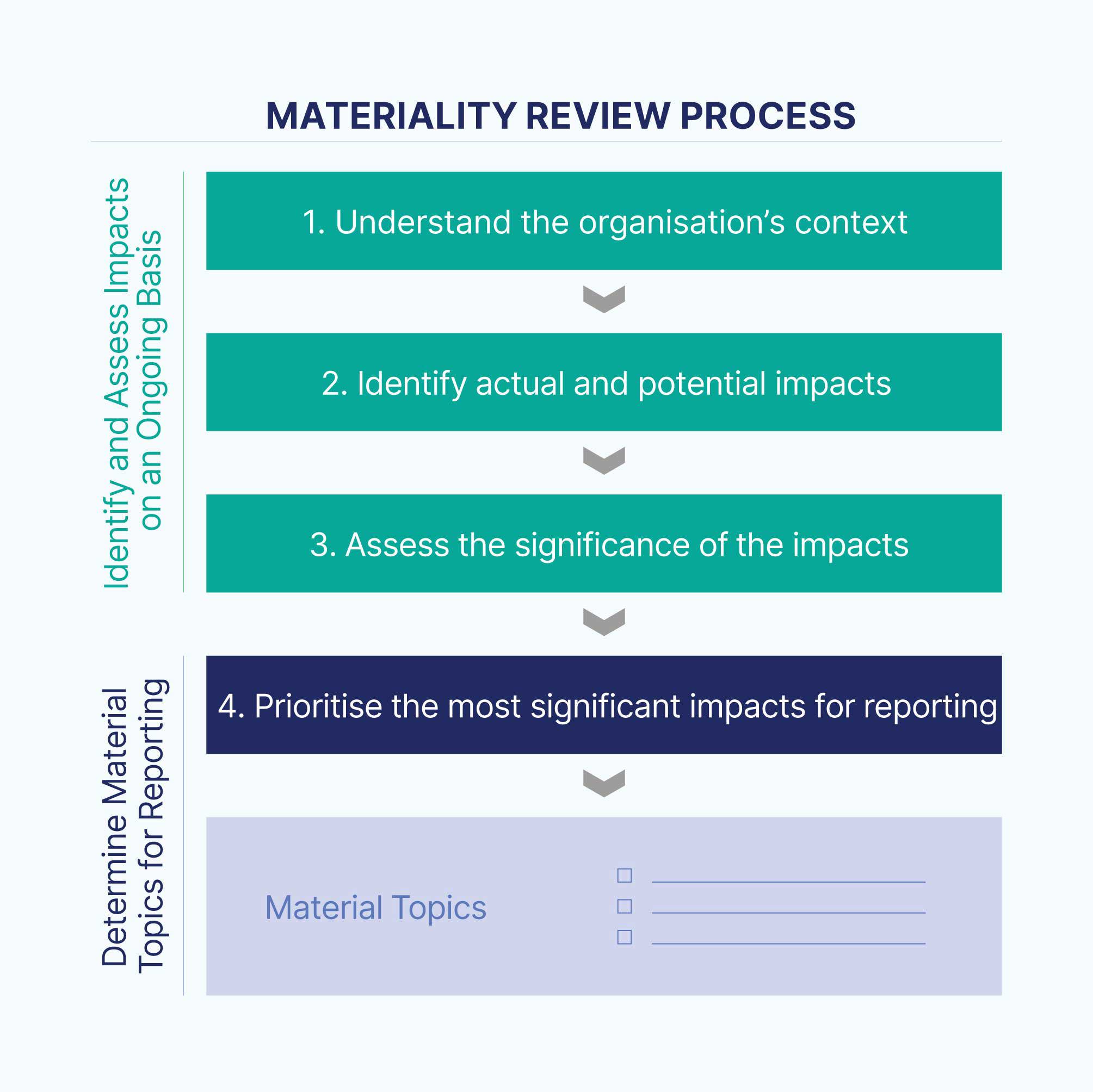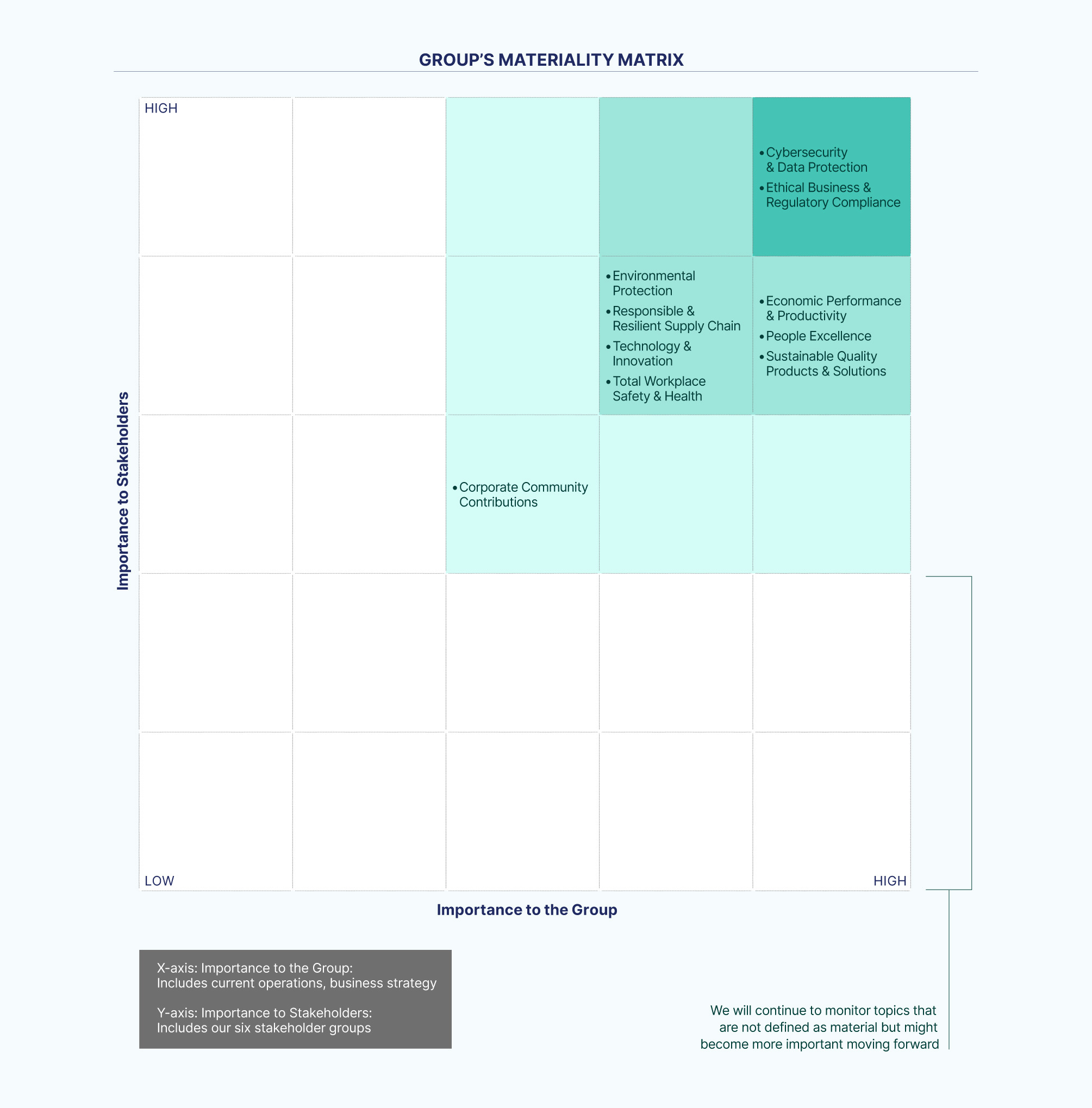- Aerospace
-
Smart City
Smart Mobility (Rail)
Smart Mobility (Road)
-
- Marine
- Defence
- Public Security
- Digital Tech
-
Global
Materiality Assessment
Materiality Assessment Journey
Pre-2022 |
In 2019, the Group’s material ESG factors were reorganised into 10 areas for greater focus and clarity. They were mapped into Environmental, Social and Governance categories and aligned with the UN SDGs.
|
2022 |
We conducted a review of our material ESG factors according to GRI 3: Material Topics 2021 guidelines. We identified synergies between four of our previous material factors and regrouped them into:
Additionally, two new material factors were identified:
|
Materiality Review Process
This process is performed regularly, and the Group has identified 10 material factors spanning four broad areas of Economic, Environmental, Social and Governance. There are no changes to our material factors from the previous reporting period.


Industry Domains and Stakeholders
It is important to first understand the context of our businesses and our ecosystem. We do this by considering the industry domains that the Group operates in, which includes but are not restricted to, Aerospace and Defence, Maritime, Information and Communication Technologies, Transportation and Smart Cities.
Additionally, we consider our six material stakeholders as well as the sustainability context of our entities, focusing on those in which we have operational control.

References to International Standards and Recommendations
Based on our organisation’s business and sustainability context, we set about identifying actual and potential impacts. We made reference to GRI standards, and identified these impacts through our internal assessment and by referencing disclosure standards such as SASB – Defence and Aerospace standards, SGX Core ESG Metrics and TCFD recommendations. The requirements from these standards give us an idea of the typical impact that an organisation like ours can expect to have.
The initial process led us to identify a preliminary list of 42 topics over four broad areas (Economic, Environmental, Social and Governance) that impact or may impact others based on our business activities. We do this by considering their significance (likelihood and severity).

Stakeholder Engagement Process
Through a combination of surveys and interviews, we prioritised each topic by engaging with relevant stakeholders such as our employees, managers, senior management and our customers. A topic was considered significant if more than 75% of our stakeholders agreed that it was important to the Group. This threshold resulted in a shortlist of 23 topics, that were further grouped and distilled into 10 material factors.

Materiality Assessment Results
Through the review, we identified synergies between four of our previous material factors: Economic Performance, Productivity, Green Products and Solutions, and Quality. These have been regrouped into:
- Economic Performance & Productivity
- Sustainable Quality Products & Solutions
Additionally, two new material factors were identified:
- Technology & Innovation
- Cybersecurity & Data Protection
We will continue to monitor topics that are not defined as material but might become more important moving forward.

Industry Domains and Stakeholders
It is important to first understand the context of our businesses and our ecosystem. We do this by considering the industry domains that the Group operates in, which includes but are not restricted to, Aerospace and Defence, Maritime, Information and Communication Technologies, Transportation and Smart Cities.
Additionally, we consider our six material stakeholders as well as the sustainability context of our entities, focusing on those in which we have operational control.

References to International Standards and Recommendations
Based on our organisation’s business and sustainability context, we set about identifying actual and potential impacts. We made reference to GRI standards, and identified these impacts through our internal assessment and by referencing disclosure standards such as SASB – Defence and Aerospace standards, SGX Core ESG Metrics and TCFD recommendations. The requirements from these standards give us an idea of the typical impact that an organisation like ours can expect to have.
The initial process led us to identify a preliminary list of 42 topics over four broad areas (Economic, Environmental, Social and Governance) that impact or may impact others based on our business activities. We do this by considering their significance (likelihood and severity).

Stakeholder Engagement Process
Through a combination of surveys and interviews, we prioritised each topic by engaging with relevant stakeholders such as our employees, managers, senior management and our customers. A topic was considered significant if more than 75% of our stakeholders agreed that it was important to the Group. This threshold resulted in a shortlist of 23 topics, that were further grouped and distilled into 10 material factors.

Materiality Assessment Results
Through the review, we identified synergies between four of our previous material factors: Economic Performance, Productivity, Green Products and Solutions, and Quality. These have been regrouped into:
- Economic Performance & Productivity
- Sustainable Quality Products & Solutions
Additionally, two new material factors were identified:
- Technology & Innovation
- Cybersecurity & Data Protection
We will continue to monitor topics that are not defined as material but might become more important moving forward.
Materiality Matrix
Materiality sets an important foundation for the Group’s Sustainability Approach. Assessing our material areas of focus in sustainability enables us to optimise sustainable value for all our stakeholders, which is essential to the Group’s long-term success.
ST Engineering identifies and evaluates material factors in sustainability that impact our businesses and our stakeholders from both financial and non-financial perspectives. Our six material stakeholders include customers, employees and other workers, local communities, suppliers and collaborators, shareholders and investors, and regulators and governments.
Responses from our stakeholder surveys and interviews has enabled us to quantify the relative importance of each material factor to the Group and our stakeholders. The result was the following Materiality Matrix:




